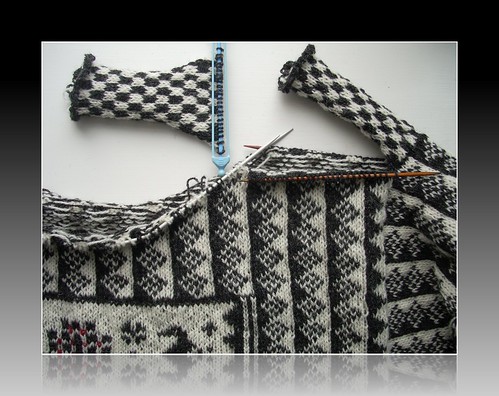The cast-on is provisional: I will unpick it and use the live stitches to knit the neckband. I caught the live stitches of the last row when picking up stitches around the armhole to make the shoulder strap continue seamlessly into the sleeve.
My intention is to pick up stitches along the strap sides, knit a row and then do a three-needle bind-off to join strap and body. (Mainly to avoid sewing, but I think it will look and feel nice too.)
Natasha's cardigan is finished! In this case I used the three-needle bind-off method for a shoulder join and added a neck gusset - I learnt how to make such gussets from Alice Starmore's book Fishermen's Sweaters.
 |
| Three-needle bind-off and neck gusset; fram- och bakstycke avmaskade tillsammans och halskil. |
If I may say so myself and I may, since this is my blog ;-) I think Natasha's cardigan is one of my best efforts! She won't receive it just yet, though. I will be talking about how I modify patterns at my LYS Litet nystan on 31 January, and this is a good example of it. Here's what the original design looks like. Nothing wrong with it - I just can't help changing a few things here and there.
This is possibly related to jazz being my favourite kind of music - I think it's so exciting hearing how the same composition can sound completely different (but still familiar) when different artists put their personal stamp on it. Or how the same artist can interprete the same composition in different ways.
"Thorsten fiskares tröja" (bygger på ett mönster av Celia B. Dackenberg) har legat i träda ett par månader medan jag har funderat på hur jag skulle få till axlar och ärmar; jag visst hur jag ville att det skulle se ut, men det är ju inte alltid samma sak som att veta hur man ska bära sig åt. Å andra sidan är det sådant som jag tycker är roligt med stickning - när jag lyckas lösa problem känner jag att jag utvecklas.
Jag tycker att sadelärmar är snyggt och bekvämt, och jag tyckte att det skulle passa på den här tröjan. Tricket var att få till rätt storlek med ett snyggt mönster som dessutom övergår på ett fint sätt i mönstret på ärmarna. Först gjorde jag en provisorisk uppläggning: den kommer jag att peta bort när det är dags att sticka halskanten, så att det inte blir någon skarv i övergången. När jag plockade upp maskor runt ärmhålet för att sticka ärmarna fångade jag upp sadeln på halva vägen, så att det inte blir någon skarv på den sidan heller.
För att fästa sadeln vid fram- och bakstyckena tänker jag plocka upp maskor längs kanten, sticka ett varv och sedan maska av dem tillsammans med maskorna på fram- respektive bakstyckena.
Natasha's kofta blev klar nyligen och jag måste säga att jag är väldigt nöjd. Fotot ovan visar axeln: jag maskade av fram- och bakstycke tillsammans och kombinerade detta med en liten halskil. Detta är en finess jag lärde mig - som så mycket annat - i boken "Fiskartröjor" av Alice Starmore.
Det dröjer ett par veckor innan Natasha får sin kofta. Den 31 januari kommer jag nämligen att prata om hur jag ändrar i beskrivningar när det är stickkafé på Litet nystan, och det här projektet är ett bra exempel att ha med. Inte för att det är något fel på originalet, tvärtom - jag kan bara inte låta bli!
 | |
| Natasha's cardigan; unfortunately, the bad light doesn't do the colours justice. |


10 comments:
Koftan är verkligen jättefin!
Wow, I have to say, I like your interpretation of the cardigan much better than the original. Everything you do amazes me!
Ett annat sätt är att sy fast "sadeln" med maskstygn.
Men oavsett så är det, som allt du gör, apsnyggt!
Kram!
If I could knit like you I would never leave my knitting room, just send food. You are such a great talent.
Helt underbara mönster. Vilken bra hopsättning av axlar. Kanske något man skulle lägga krut på att lära sig.
OMG! Vad fin Torsten blir ! Jag svimmar nästan
Of course, the cardigan is absolutely gorgeous. When I first looked at your design on the body, I thought it was an "X" "O" design from the the Shetland Islands, and wonder how many design traditions are related. Your shoulder strap is the perfect design to unite the sweater. An old neighbour lady from Sweden (long since dead but knitted into her eighties) always started off her sweaters with a checkerboard border. Is it, too, a traditional design from your part of the world?
I feel rather jealous of the people able to sit in on your lectures. Suerte!
Ron in Mexico
What an incredibly beautiful cardigan. You are definitely one of the improvisational minds of the world! Jazz in stitches.
I love both sweaters. The shoulder strap for the black and white is brilliant. Checkerboards are very important in many countries. In Peru, Incans traditionally went to incredible efforts to weave small square cloths with a 2 square wide checkerboard (ie 4 squares total) with selvages on both sides! They did this and it's still done I believe, by creating a discontinuous warp. Crazy difficult to create something that looks very simple to the average modern non-weaver. Another culture that values checkerboards a lot is Bali. The black and white checks are supposed to represent the dual nature of reality. A yin-yang thing.
Oj, så fin den blev. Hoppas jag får chansen att se den i verkligheten.
Post a Comment